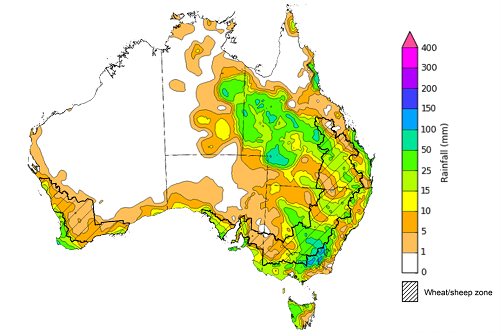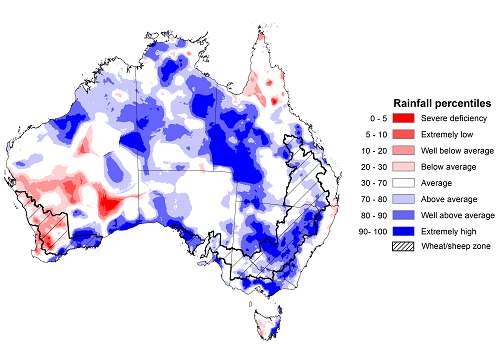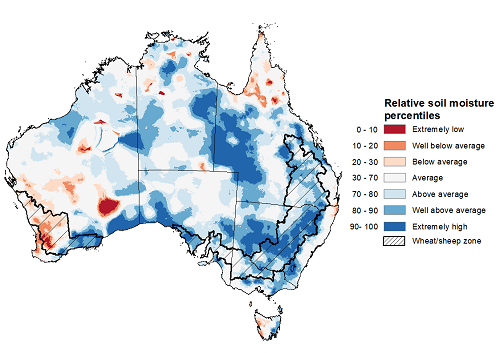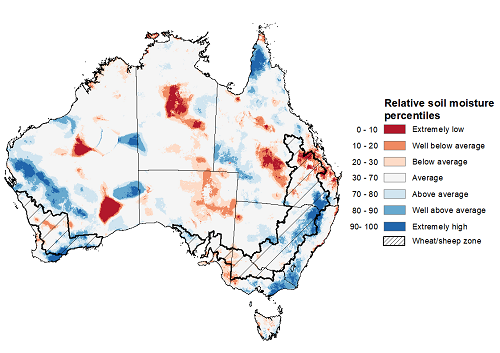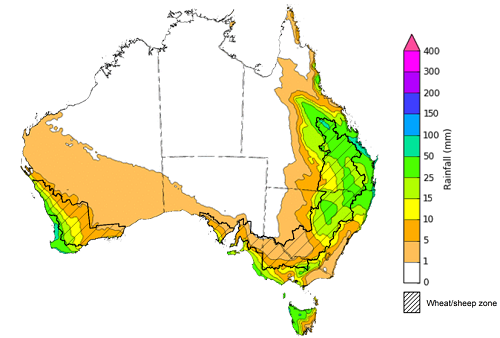Key issues
- During the week ending 30 June 2021, low pressure systems and associated cold fronts brought substantial rainfall to parts of eastern Australia. However, high pressure systems restricted rainfall across the western half of Australia during the week.
- Substantial rainfall across most eastern cropping regions will support plant development and potential yields. Despite the low rainfall conditions in some cropping regions, previous heavy falls and stored soil moisture are likely to have provided sufficient water availability to support the development of established crops in most regions.
- Rainfall during June 2021 was above average to well above average across much of New South Wales, western Queensland and the Northern Territory, southern parts of Victoria, south-western areas of South Australia and parts of southern and northern Western Australia. Rainfall was below average to well below average during June 2020 for parts of the west of Western Australia.
- Rainfall across eastern Australia has supported the establishment and growth of winter crops and pastures. However, well above average rainfall has resulted in isolated flooding in parts of south-eastern Victoria and waterlogging in parts of central and northern New South Wales.
- During the next 8 days to 8 July 2021, low pressure systems to the west and east of Australia are likely to bring rainfall to parts of New South Wales, Queensland, Victoria, South Australia, the south-west of Western Australia and Tasmania.
- The forecast rainfall for eastern cropping regions will support the growth of early sown crops, the germination and establishment of later sown crops, as well as boosting soil moisture. With well above average soil moisture levels in parts of north-eastern New South Wales, there is a risk of waterlogging, which could negatively affect crop growth. Dry conditions are expected to continue for the Mallee regions of Victoria and South Australia, which are still awaiting substantial rainfall to consolidate production prospects for the 2021 winter cropping season.
- Water storage in the Murray–Darling Basin (MDB) increased by 560 gigalitres (GL) between 23 June 2021 and 30 June 2021. The current volume of water held in storage is 16,134 GL, which represents 64% of total capacity. This is 46% or 5,053 GL more than at the same time last year.
- Allocation prices in the Victorian Murray below the Barmah Choke decreased from $94 per ML on 19 June 2021 to $79 per ML on 27 June 2021. Prices are lower in the Murrumbidgee due to the binding of the Murrumbidgee export limit.
Climate
[expand all]
Rainfall this week
During the week ending 30 June 2021, low pressure systems and associated cold fronts brought substantial rainfall to parts of eastern Australia. However, high pressure systems restricted rainfall across the western half of Australia during the week.
Rainfall totals of between 10 and 50 millimetres were recorded across parts of New South Wales, Queensland, Victoria, southern South Australia, south-western Western Australia, the east of the Northern Territory and Tasmania. Rainfall totals in excess of 50 millimetres were recorded in isolated parts of south-eastern New South Wales, central Queensland and eastern Victoria.
In cropping regions, rainfall totals of between 10 and 50 millimetres were recorded in parts of New South Wales, Queensland, eastern and southern Victoria, western and central South Australia and isolated parts of northern and eastern Western Australian cropping regions. Little to no rainfall was recorded across most cropping regions in Western Australia and parts of western Victoria and eastern South Australia during the week ending 30 June 2021.
Substantial rainfall across most eastern cropping regions will support plant development and potential yields. Despite the low rainfall conditions in some cropping regions, previous heavy falls and stored soil moisture are likely to have provided sufficient water availability to support the development of established crops in most regions.
Rainfall for the week ending 30 June 2021
©Commonwealth of Australia 2021, Australian Bureau of Meteorology - Issued: 30/06/2021
Note: The rainfall analyses and associated maps utilise data contained in the Bureau of Meteorology climate database, the Australian Data Archive for Meteorology (ADAM). The analyses are initially produced automatically from real-time data with limited quality control. They are intended to provide a general overview of rainfall across Australia as quickly as possible after the observations are received. For further information go to http://www.bom.gov.au/climate/rainfall/
Monthly rainfall
Rainfall during June 2021 was above average to well above average across much of New South Wales, western Queensland and the Northern Territory, southern parts of Victoria, south-western areas of South Australia and parts of southern and northern Western Australia. Rainfall was below average to well below average during June 2020 for parts of the west of Western Australia.
The El Niño–Southern Oscillation (ENSO) remained neutral throughout June, having had little influence on Australia’s climate. Meanwhile, the Indian Ocean Dipole (IOD) was consistently negative, and the Southern Annular Mode (SAM) remained positive throughout June. A negative IOD is associated with more rainfall over eastern and southern Australia, and a positive SAM also typically results in more rainfall for parts of eastern and southern Australia but drier in other parts of the south. Little or no rainfall is typically recorded across much of northern Australia during June as it is the northern dry season. Cold fronts and troughs generated above average rainfall across much of southern and central Australia during June. High pressure systems contributed to below average rainfall for parts of Western Australia.
June rainfall was well above to above average across cropping regions in New South Wales and parts of South Australia. Near average rainfall fell across Queensland, Victoria and South Australia cropping regions. Rainfall was severely deficient to below average for much of Western Australia in June.
Rainfall across eastern Australia has supported the establishment and growth of winter crops and pastures. However, well above average rainfall has resulted in isolated flooding in parts of south-eastern Victoria and waterlogging in parts of central and northern New South Wales. The parts of western Victoria and eastern South Australia that experienced very dry conditions during autumn have likely received enough rainfall to support germination and establishment of crops, but more rainfall is needed to ensure continued growth and crop development. Despite below average rainfall in June across most cropping regions of Western Australia, crop production conditions remain favourable as a result of above average rainfall in May and stored soil moisture, which supported plant growth.
Rainfall percentiles for June 2021
Note: Rainfall for June 2021 is compared with rainfall recorded for that period during the historical record (1900 to present). For further information, go to http://www.bom.gov.au/water/
Source: Bureau of Meteorology
Monthly soil moisture
Upper layer soil moisture in June 2021 was average to well above average for this time of year across much of Australia, reflecting rainfall patterns during the month. However, modelled upper layer soil moisture was well below average to below average across parts of the west of Western Australia. Upper layer soil moisture is important at the beginning of the winter cropping season since plant germination and establishment utilise this moisture.
Upper layer soil moisture was above average to well above average for this time of year across most cropping regions in New South Wales, Queensland, Victoria, South Australia and parts of eastern Western Australia. Soil moisture was well below average to below average across central and northern Western Australia cropping regions. However, this is likely to have little impact on crop production potential as most crops were well established following the above average rainfall in April and May.
Modelled upper layer soil moisture for June 2021
Note: This map shows the levels of modelled upper layer soil moisture (0 to 10 centimetres) during June 2021. This map shows how modelled soil conditions during June 2021 compare with June conditions modelled over the reference period (1911 to 2016). Dark blue areas on the maps were much wetter in June 2021 than during the reference period. The dark red areas were much drier than during the reference period. The bulk of plant roots occur in the top 20 centimetres of the soil profile. Soil moisture in the upper layer of the soil profile is therefore useful indicator of the availability of water, particularly for germinating seed.
Source: Bureau of Meteorology (Australian Water Resources Assessment Landscape model)
Lower layer soil moisture for June 2021 was average to above average for this time of year across much of Australia, with well above average soil moisture in isolated parts of north-eastern, south-eastern and south-western Australia. Lower layer soil moisture was well below average to below average across parts north-eastern and central Australia, and scattered parts of Western Australia.
In cropping regions, lower layer soil moisture was above average to well above average for parts of north-eastern and central New South Wales, south-eastern Queensland and eastern Western Australia. Lower layer soil moisture was well below average to below average in cropping regions across parts of northern Queensland, western Victoria, eastern South Australia and northern Western Australia cropping regions. Lower layer soil moisture was average across the remainder of cropping regions.
Modelled lower layer soil moisture for June 2021
Note: This map shows the levels of modelled lower layer soil moisture (10 to 100 centimetres) during June 2021. This map shows how modelled soil conditions during June 2021 compare with June conditions modelled over the reference period (1911 to 2016). Dark blue areas on the maps were much wetter in June 2021 than during the reference period. The dark red areas were much drier than during the reference period. The bulk of plant roots occur in the top 20 centimetres of the soil profile. The lower layer soil moisture is a larger, deeper store that is slower to respond to rainfall and tends to reflect accumulated rainfall events over longer time periods.
Source: Bureau of Meteorology (Australian Water Resources Assessment Landscape model)
Rainfall forecast for the next eight days
Low pressure systems to the west and east of Australia are likely to bring rainfall to parts of New South Wales, Queensland, Victoria, South Australia, the south-west of Western Australia and Tasmania over the next 8 days. However, high pressure systems across southern and central Australia are expected to restrict rainfall for much of central and northern Australia over the next 8 days to 8 July 2021.
Rainfall totals of between 10 and 50 millimetres are forecast for north-eastern New South Wales and eastern Queensland, as well as parts of Victoria, the south-east of South Australia, south-west Western Australia and western Tasmania.
In Australia’s cropping regions, rainfall totals of between 10 and 50 millimetres are forecast for northern New South Wales, most of Queensland, and parts of Western Australia. Rainfall totals of less than 10 millimetres are forecast for cropping regions in southern New South Wales, much of Victoria and South Australia, as well as parts of Western Australia.
The forecast rainfall for eastern cropping regions will support the growth of early sown crops, the germination and establishment of later sown crops, as well as boosting soil moisture. With well above average soil moisture levels in parts of north-eastern New South Wales, there is a risk of waterlogging, which could negatively affect crop growth. Dry conditions are expected to continue for the Mallee regions of Victoria and South Australia, which are still awaiting substantial rainfall to consolidate production prospects for the 2021 winter cropping season.
Total forecast rainfall (mm) for the period 1 July to 8 July 2021
©Commonwealth of Australia 2021, Australian Bureau of Meteorology - Issued: 30/06/2021
Note: This rainfall forecast is produced from computer models. As the model outputs are not altered by weather forecasters, it is important to check local forecasts and warnings issued by the Bureau of Meteorology.
Water
Water storages, water markets and water allocations - current week
The Tableau dashboard may not meet accessibility requirements. For information about the contents of these dashboards contact ABARES.
Commodities
Information on weekly price changes in agricultural commodities is now available at the Weekly commodity price update.

